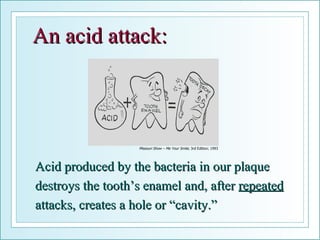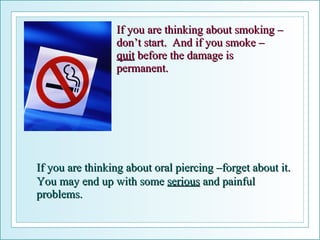Oral Health and You
- 1. Oral Health and You Grades 9-12 Missouri Department of Health and Senior Services Division of Community and Public Health Oral Health Program
- 2. Your oral health can affect your overall health.
- 3. Your teeth are important for: Chewing Talking Appearance
- 4. But did you know that problems in your mouth could create problems elsewhere in your body?
- 5. Let’s examine the first thing you think of when “oral health” is mentioned: Tooth decay…
- 6. Tooth decay is caused by: Bacteria found in plaque Sugary foods and drinks Improper or neglected tooth brushing Bacteria in the PLAQUE in your mouth turns food (sugar) on your teeth into ACID. Missouri Show – Me Your Smile ; 3rd Edition; 1993
- 7. To understand an acid attack on your teeth, we need to first look at the tooth structure. The Enamel is… The outside layer. - A hard protective covering. - The hardest substance in our body, even harder than bone. The Pulp is… The inside layer. - The live part of the tooth. - Has blood vessels and nerves. The Dentin is… Underneath the enamel. - Makes up the largest part of a tooth. - Hard, but not as hard as enamel. Missouri Show – Me Your Smile ; 3rd Edition; 1993
- 8. An acid attack: Acid produced by the bacteria in our plaque destroys the tooth’s enamel and, after repeated attacks, creates a hole or “cavity.” Missouri Show – Me Your Smile ; 3rd Edition; 1993
- 9. Diet and Nutrition Your diet includes all the food you eat each day whether the food is healthy or not (junk food). Your diet needs to include a variety of foods in order for you to have good nutrition and good oral health.
- 10. Snacking Snacks between meals are a great way to provide food you need daily for: Growth Energy Learning Healthy Bones, Skin and Teeth
- 11. But, if you make poor choices, snacks can cause dental problems… Frequent soda drinking can cause tooth decay when sugar (and acid) combine with bacteria in the mouth to form more acid. Even diet, sugar-free sodas contain acid which harms your teeth. Each sip causes a 20-minute acid attack that may cause tooth decay. Soda Drinking Missouri Dental Association “Stop The Pop” (PDF)
- 12. Results of Tooth Decay: Pain and infection Difficulty in speaking and chewing Difficulty concentrating Loss of self-esteem Lost school days Poor nutrition Cost of care
- 13. Besides tooth decay, harmful habits or activities can damage your teeth… Keep Foreign Objects Out of the Mouth Don’t Use your teeth to: Cut things Hold onto pens/pencils Bite nails Crack nuts Crunch ice Open bottles or hairpins
- 14. Sports Seek immediate treatment if a tooth is knocked out (within 30 minutes). - Do NOT clean the tooth. - Do NOT touch the wound site. - Keep the tooth WET . (Put it in a glass of cool water, milk or a wet cloth). Always wear a mouth guard for physical contact sports
- 15. Smoking
- 16. All Tobacco Products are Harmful
- 17. Smoking Causes Stained teeth Plaque build-up Bad breath Mouth sores Gum disease Tooth loss http://drwendellpurling.onsmartpages.com Greater chance for oral cancer
- 18. Smokeless Tobacco Causes: Tooth abrasion Gum recession Increased tooth decay Tooth discoloration Bad breath Addiction Oral cancer www.umanitoba.ca
- 20. Oral/perioral piercings can cause: Chipped or cracked teeth Infection of the pierced site as well as an infection in the bloodstream Abscesses or cysts Nerve damage An allergic reaction to “cheap” metal Increased risk for Hepatitis, Tetanus, HIV “ The Perils of Oral Piercing”; RDH, March 2006 www.mcgrathdental.com
- 21. Eating Disorders (Bulimia & Anorexia) What you perceive as “looking good” actually causes… Effects of “purging” or (vomit) on the inside of the teeth. Self-destruction Depression Withdrawal Malnutrition Health/Dental problems Death www.mappsd.org
- 22. Methamphetamine If you’re using this… “ meth mouth” It won’t be long before your teeth look like this… “ meth” www.mappsd.org
- 23. Now let’s examine some other things you may not know….
- 24. The #1 cause of tooth loss in adults is not tooth decay, but…. Gum Disease American Academy of Periodontology; “Facts and Fallacies About Periodontal Disease
- 25. What is gum disease? A bacterial infection in the mouth caused by the accumulation of plaque on the teeth www.doctorfernandofuentes.cl/
- 26. Gingivitis Gingivitis is a mild form of gum disease, and the most common. It is reversible and involves only the gum tissues around the teeth. Signs: Bleeding when brushing or flossing, puffy, red tissues between the teeth, and pain or tenderness. www.doctorfernandofuentes.cl
- 27. Periodontitis Periodontitis is the more destructive form of gum disease. It is not reversible and involves permanent loss of the gums and underlying bone eventually leading to tooth loss. Signs: Chronic bad breath, receding gums, and teeth that are loose (bleeding may or may not occur). www.altcorp.com
- 28. Recently scientists have found a possible link between Gum Disease and certain conditions like: Diabetes Heart Disease Pre-term, low birth weight babies Connections: Oral & Systemic Health Review; July 2005, Vol.1 No.1
- 29. Why should you be concerned?
- 30. Diabetes Diabetes is on the rise in children and young adults due to poor nutrition, lack of exercise and obesity. If you have diabetes, gum disease may affect your ability to control your blood sugar. Uncontrolled diabetes can lead to serious complications… American Dental Association; “Diabetes, A Growing Epidemic of All Ages”
- 31. Heart Disease T he #1 cause of death in the U.S. Evidence suggests that the bacteria found in your mouth from gum disease may have an effect on blood vessel walls, causing inflammation and blockage of blood flow to the heart and brain. This could result in a heart attack or stroke… “ The Significance of Periodontal Infection In Cardiology”; Grand Rounds in Oral –Systemic Medicine
- 32. Pregnancy If you are pregnant, you are more prone to develop gum disease. Gum disease may trigger a “pre-mature” birth. Premature babies can have lifelong problems… Connections: Oral & Systemic Health Review; July 2005, Vol.1 No.1
- 33. As a young adult, what you do now can prevent many problems from occurring later on….
- 34. By investing only six minutes each day, both tooth decay and gum disease can be prevented by you… … That’s two minutes twice each day spent on brushing and two minutes once a day for flossing.
- 35. Proper Brushing Tilt the brush at a 45° angle against the gumline. Brushing only 2-3 teeth at a time, gently brush the outside , inside and chewing surfaces of all your teeth. Use short back-and-forth or circular strokes. Don’t forget to brush your tongue to remove bacteria and freshen your breath! Missouri Department of Health and Senior Services Oral Health Program Missouri Department of Health and Senior Services Oral Health Program
- 36. Proper Flossing Now, gently follow the curves of your teeth, sliding the floss up and down the tooth’s surface a few times. Be sure to go below the gumline. Using your middle fingers, wrap about 18” of floss around them (but not too tightly). Leave about an inch or two of floss between your hands. Missouri Department of Health and Senior Services Oral Health Program Missouri Department of Health and Senior Services Oral Health Program
- 37. Your teeth were meant to last you a lifetime… So now it’s up to you!
- 38. Personal Choices Choose healthy snacks and eat fewer foods that are high in sugar. Limit soda drinking and rinse your mouth afterward.
- 39. If you are thinking about smoking – don’t start. And if you smoke – quit before the damage is permanent. If you are thinking about oral piercing –forget about it. You may end up with some serious and painful problems.
- 40. If you’re hiding an eating disorder… Talk to your school nurse for confidential nutritional counseling Get out and get active - have some fun Enjoy life with your family and friends
- 41. … Quit taking risks news.bbc.co.uk www.fade.org.nz www.fade.org.nz www.mappsd.org
- 42. If you already… - Have your tongue/mouth pierced - Have diabetes - Know you are pregnant … Care of your mouth, teeth and gums is extra important .
- 43. Your oral health contributes to your overall health And by practicing good oral hygiene habits you can help prevent tooth decay, gum disease and possibly some serious health issues….
- 44. Brush and Floss Daily for Good Oral Health! Additional Resources: 1) Missouri Dental Association “Stop The Pop” presentation (PDF) www.modental.org 2) Frances D. Wolfe, “The Perils of Oral Piercing”; RDH, March 2006 3) American Academy of Periodontology; “Facts and Fallacies About Periodontal Disease”, www.perio.org 4) David Paquette, DMD,MPH,DMSc et. al, “Oral Inflammation, CVD, and Systemic Disease”; Connections: Oral & Systemic Health Review; July 2005, Vol.1 No.1 5) American Dental Association; “Diabetes, A Growing Epidemic of All Ages”, JADA, Vol. 134, Oct. 2003 6) American Diabetes Association, www.diabetes.org 7) Stanley Shanies, MD,MPH, FACP and Casey Hein, BSDH, MBA, “The Significance of Periodontal Infection In Cardiology”; Grand Rounds in Oral –Systemic Medicine. February 2006, Vol. 1, No. 1. 8) Photos: Microsoft product box shots reprinted with permission from Microsoft Corporation. All photos obtained from office.microsoft.com/clipart unless otherwise noted.











































